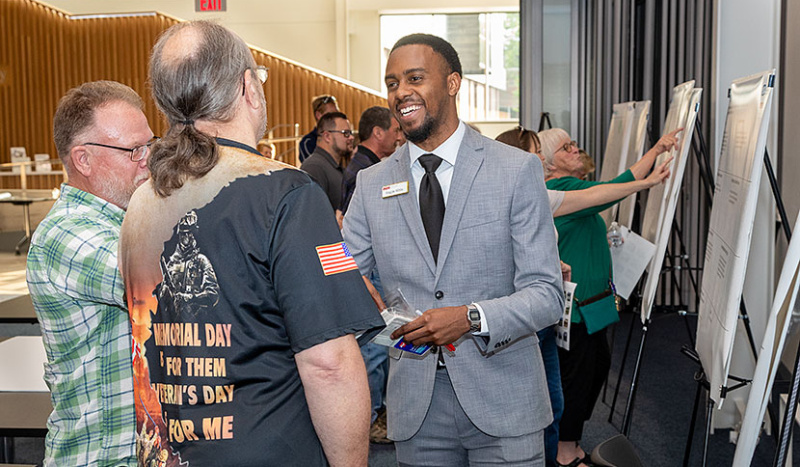As the City’s housing study wraps up this fall with a report and recommendations from consultant APD Urban Planning + Management expected in October, the Restore SGF initiative to improve housing conditions and raise residential property values in Springfield’s historic neighborhoods continues to move forward.
APD and the City’s Planning & Development department hosted a second housing study community meeting in June to provide an opportunity for residents to learn the results of APD’s “windshield survey” of the city.
Earlier this year, APD drove Springfield neighborhoods with a 360-degree camera, surveying nearly 48,000 housing structures to gather information about housing conditions, age and values; vacant buildings and lots; characteristics of the neighborhoods in each City Council zone; the gap between housing/rental prices and incomes; and the types of housing in Springfield.
Major takeaways
- 92% of housing in Springfield are single family residential.
- The most common multifamily housing type is duplex.
- Multifamily homes are primarily located near Missouri State University.
- 97% of all housing structures are occupied.
- Vacant residential lots can be found in most neighborhoods.
- 77% of all housing is in good condition.
- 21% of all housing structures are in fair to worse condition.
- 44% of all housing structures were built between 1950 and 1970.
- 21% were built between 1980 and 2020.
- 30% were built between 1840 and 1940.
- Housing structures in Zone 1 (northwest quadrant of the city) have a broader range of conditions.
- Attendees of the February housing study community meeting listed townhomes, starter homes, workforce housing and tiny homes as housing types missing from Springfield neighborhoods.
- Attendees of the February community meeting listed the following as strengths of Springfield neighborhoods: neighborhood establishment, community engagement, historic homes, diversity in housing, neighborhood character, accessible/walkable communities, affordable homes, transit-oriented development, quality schools and parks/greenspace.
- Weaknesses were ineffective landlords, unaffordable housing, lack of viable rental housing, lack of variety in housing types, vacant housing, blight and decay, walkability/connectivity, development/preservation.
APD’s full presentation from the June meeting can be viewed from springfieldmo.gov/housingstudy. APD will ultimately provide recommendations on how the City can improve housing metrics through policy changes. Zoning code recommendations could include rules on what type of housing can be built, parking requirements, minimum lot sizes and density restrictions.
Restore SGF is following the housing study closely, as its findings will help identify initial target neighborhoods for programming.
“We have established our Neighborhood Selection Committee to begin working on a recommendation on the initial four neighborhoods we’ll begin work in,” said Richard Ollis. “Committee members are Interim Executive Director Dana Elwell, Nancy Williams (Habitat for Humanity), Amy Blansit (Drew Lewis Foundation at The Fairbanks), Barbra Wallace (Central Bank), state Rep. Bill Owen, Andrew Doolittle (Everett Homes) and Becky Volz (NAC chair). They will be working over the next 60 days and will present their recommendation to our full board on Aug. 17.”

Elwell began his role with Restore SGF in June and has extensive experience in lending, having served in leadership roles with Guaranty Bank, First City National Bank, Boatmen’s Bank and Central Mortgage Bancshares. He is also a founding member of Springfield Community Land Trust and continues to serve on its board. Elwell has also served on the Habitat for Humanity Springfield board of directors, as chair of Community Partnership of the Ozarks’ Housing Collaborative, was a founding member and board president of the Affordable Housing Action Board, a founding member and board president for the Nixa Community Foundation and chair and board member of the Nixa Planning & Zoning Commission.
In addition to gaining Elwell, as of July 1, Restore SGF will have a home of its own at 1409 W. Sunshine, near Elfindale.
Watch RestoreSGF.com for additional updates.
Funding commitments
Community Foundation of the Ozarks has pledged $20,000 over five years ($100,000 total) in grant funding for Restore SGF, plus $500,000 for the initiative’s revolving loan fund.
OakStar Bank, Commerce Bank, Old Missouri Bank, Great Southern Bank, Guaranty Bank, Arvest Bank, Legacy Bank, Mid Missouri Bank and Regent Bank have committed $10,000 over three years ($30,000 total) in grant funding, while Central Bank has committed $20,000 over three years ($60,000 total) in grant funding. Great Southern Bank, Legacy Bank, Central Bank and Regent Bank have each committed $250,000 for the revolving loan fund.
In addition to these commitments, many financial institutions have agreed to commit loan and mortgage dollars to Restore SGF’s targeted neighborhoods.








